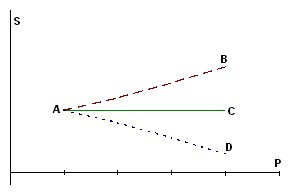The supply function S(p) describes the relationship between the market price of a good and its supply in an isolated market for that good. In general, it should be assumed that the product in question is produced at a sufficiently large number of competing enterprises. In such a situation, it is natural to assume that each manufacturer strives for the greatest profit, and his individual output of the product increases as the price of this product increases. But then the total supply of goods on the market S(p), as the sum of individual outputs, is an increasing function of the price, i.e. S′(p)>0.
In more specific situations (oligopoly, monopoly), the behavior of the enterprise, as the example given above shows, is not necessarily determined by the desire for maximum profit; since with an increase in price, the producer can ensure a noticeable increase in profits without an increase in the volume of output. Thus, strictly speaking, cases where S(p)=const or even S′(p)<0 (Figure 6.9) should be investigated.

Rice. 6.9. Ascending, unchanging and decreasing functions of the offer
Here’s the offer’s family of features. Line AB corresponds to perfect competition and the desire of producers to maximize profits, the AC line corresponds to unchanged output, which, nevertheless, makes it possible to conduct the economy with a decent profit in conditions of imperfect competition; the AD line represents a declining volume of production, which is possible in conditions of monopoly and a sharp increase in prices.
In the further analysis, the state of perfect competition and the growth of supply depending on price increases are considered as the main one. For practical calculations, two main types of supply functions are used, the parameters of which are determined by processing statistical data:
1) Linear function:
S(p) = b0 + b1p (b0 > 0; b1 > 0);
2) Power function:
S(p) = b0 pβ (b0 > 0; β > 0).
The supply elasticity ratio (ESp) shows how much the supply of a product will increase if its price rises by 1%.
For a linear sentence function:

where ![]() are the average values of the price and supply according to the observation table.
are the average values of the price and supply according to the observation table.
For the power function:

For the supply function, defined as the solution of the profit optimization problem discussed above (see*), we have:

Price elasticity of supply:

i.e. is entirely determined by the nature of fixed and variable costs.
In a more general case, the supply volume of a j-th good is considered not only depending on its price (pj), but also on the prices of other goods. In this situation, the system of supply functions is as follows:
![]() ,
,
where n is the number of items of goods.
Products i and j are called competing if cross-elasticity:
![]()
i.e. when the price ![]() increases, the output of the j-th product decreases; the goods are complete, if
increases, the output of the j-th product decreases; the goods are complete, if
![]()
In this case, the growth in the production of one product necessarily causes an increase in the output of another.